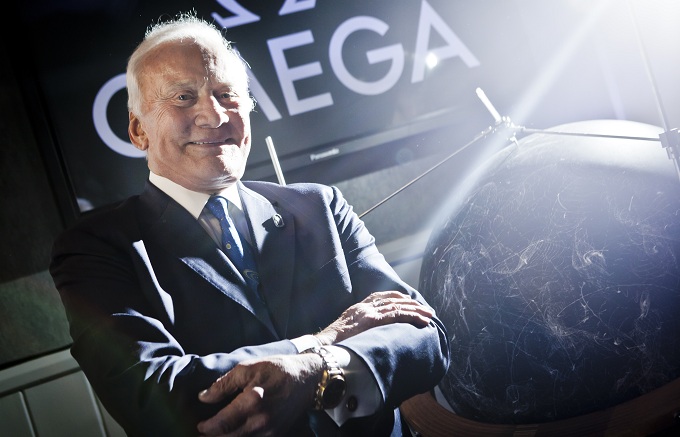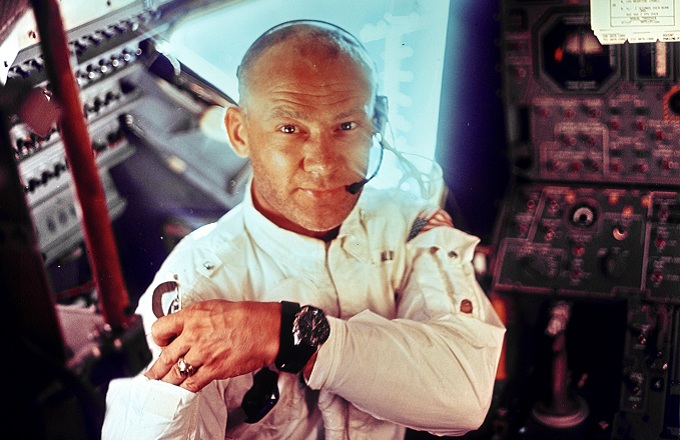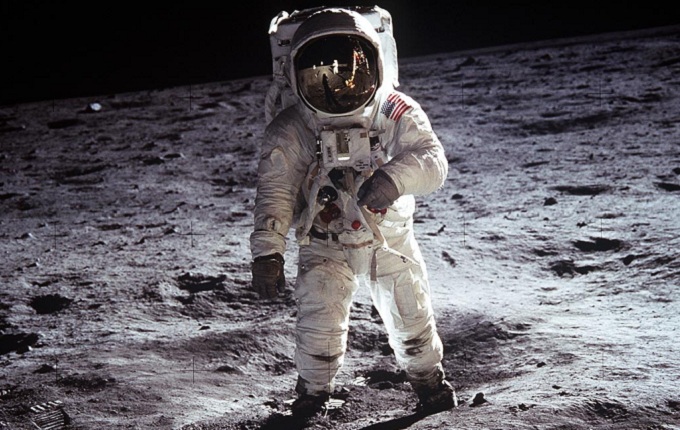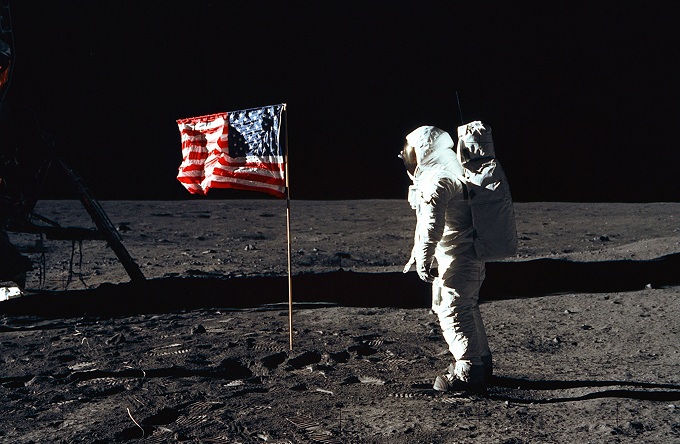Buzz Aldrin Tells Moon Landing Story

Buzz Aldrin was the lunar module pilot on Apollo 11 the first manned lunar landing in history. He was the second human being to set foot on the surface of the Moon, following mission commander Neil Armstrong. His story and spirit of adventure remains one of the most inspiring in mankind’s history.
Swiss watch masters Omega were responsible for making the timepiece he wore on his historic lunar landing and brought him to the London 2012 Olympics. In the intimate surroundings of the luxurious Omega House, Buzz Aldrin recounted his extraordinary life story and shared details of his own experiences of one of the most iconic and significant moments in human history.
Astronaut Buzz Aldrin spoke about the birth of the space race, the challenges of reaching the lunar surface, why Neil Armstrong was the first to set foot on the Moon and explains his own iconic first lunar words “Magnificent Desolation”. Finally Buzz speaks of his continuing adventures on earth and his hopeful ambitions for the continued exploration of space by an ambitious and excited next generation. Read the full speech below:
Good afternoon and welcome to the explorer space event at the Omega House. I’d like to thank Omega for inviting me to come to the Olympics one again and for the opportunity to share my story with you this evening. I truly appreciate our partnership and their support of the space program. Engaging in mutually valuable partnerships is the key to pioneering new frontiers, whether it is the far reaches of space or keeping perfect time. You’ll notice I have two watches on!
Luck has always been a key element in my life. I’ve been blessed to be in the right place at the right time. But along with timing, keeping a good balance is necessary as is viewing yourself as part of a team. Just as we did with Apollo. Before I get ahead of myself, let me tell you a bit about my grand adventure that never would have happened without the support of many people working together towards a shared goal.
Mankind has dreamed for centuries of reaching space, the moon and even the stars. But it wasn’t until the 20th Century that man took his first powered flight in 1903 on a windy morning the Wright brothers’ flyer took their first flight, defying gravity. My mother Marion Moon was born that same year, only 66 years later Neil and I stepped onto the Moon, fulfilling the dreams of millions of people. This is my story of how we got there and how when a team works well together the world can achieve the next impossible dream.
I took my first flight at age two with my father Edwin Eugene Aldrin. I was a junior for a while then I changed my name to Buzz. He was an engineer and an aviation pioneer. He was a friend of Limburg and Orville Wright. At that time we flew in a Lockheed Vega single engine plane painted red to look like an eagle. Which would one day be the name of our spacecraft.
Surrounded by the influence of aviation I joined the air force after graduating from the military academy. My father had also been in the air force and he was a civilian aviation manager and directed the aviation division of a company before becoming the commanding officer of Newark Airport in New Jersey. I was born in New Jersey. He also worked as a consultant for the manned space flight safety director of NASA.
After training I was in the Korean War as a jet fighter pilot where I flew 66 combat missions in my F86 Saber Jet ad shot down two enemy MIG 15 aircraft. Following the Korean War I was stationed in Germany on alert flying F100s in the late 1950. The cold war between the USA and The Soviet Union was escalating and tensions were high. Actually we were flying tactical missions in preparations for nuclear deliver. A young kid delivering the nuclear weapon.
In October of 1957 I was still stationed in Germany and the Soviet Union pulled off a sudden and unexpected technological feat. They launched sputnik into orbit and in response a year later America formed the National Aeronautics and Space Administration (NASA) with the goal of reaching space. The space age was born and the space race was about to begin. On April 12th 1961 the Soviet made an incredible achievement by sending the first Human into space, Cosmonaut Yuri Gagarin for one full orbit of the earth. In response only a few weeks later NASA launched America’s first Mercury astronaut Alan Shepherd on a 15 minute sub orbital flight that touched the edge of space. This was definitely impressive but we all wondered what’s next.
President John F. Kennedy asked NASA and its ranks of engineers and rocket scientists what was possible. They told him that it would take at least 15 years before we could put a man on the moon. But instead of accepting what was possible on May 25th 1961 just three weeks after Alan Shepherd’s flight, President Kennedy challenged America to commit to the goal of landing a man on the moon before the end of the decade. We hadn’t even put a man in orbit! The rockets and spacecraft needed to go beyond earth’s orbit didn’t exist.
Many thought that the challenge was impossible. We didn’t have the knowhow, but we did have a leader with the vision, determination and confidence that we could get there. By publically stating our goal and by putting a very specific time period on a specific time period, President Kennedy gave us no back door. We either had to do it or fail and no-one was interested in failing.
If space was going to be our next frontier then I wanted to be a part of getting there. After I completed my tour of duty in Germany I decided to continue my education and received my doctorate in astronautics at MIT (Massachusetts Institute of Technology). For my thesis I adapted my experience as a fighter pilot intercepting enemy aircraft to devise a technique for two manned space craft to meet in space, called orbital space rendezvous. Little did anyone know, including me, how critical this work would later be in our successfully landing on the moon.
The first time I applied to be a NASA astronaut I was turned down, because I hadn’t been trained as a test pilot. But I was determined and applied again. This time my jet fighter experience and NASA’s interest in my space rendezvous technique influenced them to accept me in the third group of astronauts. There I became known by my peers as Dr Rendezvous. A very clever NASA engineer figured out that if we used four specialised spacecraft we could land on the moon. A command module, a service module that would remain in orbit around the moon and an ascent and descent lunar module to land and later rendezvous with the command & service module.
This all meant that the lunar landers motor didn’t have to be so big and could be left on the lunar surface. This is where my MIT studies really paid off. The critical part of this process would be the ability to rendezvous from the surface with the two spacecraft in orbit about the moon. This was such a critical step because without it there would be no way to rescues the men left stranded on the moon. Luckily my MIT work was exactly what was needed.
Mercury was the first stage of the space programme, followed by the Gemini programme used to fill the gap as the rockets were being developed for the Apollo programme. Gemini was an integral part of our training that helped us how to do spacewalks and other computer things. As an avid scuba diver, I was the first astronaut to train underwater to simulate the weightlessness of space.
During my first space flight as pilot of Gemini 12, I was able to set a world record of 5 ½ hours of space walking while circling the globe every 90 minutes at a speed of 17,000 miles per hour. What a sight to behold the earth below while floating outside the capsule. After 5 days in Orbit Jim Lovell and I returned to earth having completed the final mission in the Gemini programme.
It was November 1966 and we only had three years left to accomplish Kennedy’s challenge of landing a man on the Moon by the end of the decade. Gemini had prepared us for Apollo missions, but we still had a lot of work to do. In all there was a team of over 400,000 people working together on a common dream. The engineers and technicians who were designing and building a Saturn 5 rocket; scientists aerospace industry contractors, NASA administrators and even the seamstress that sewed our space suites. It took a united effort to accomplish everything that was needed.
At last we reached the day when the Saturn 5 rocket was first rolled out the vehicle assembly building on its way to the launch pad. The timing of crew rotation was just right for Neil Armstrong, Michael Collins and then me to be chosen as the crew for this mission. So on July 16th 1969 our launch date finally arrived.
We took the elevator up the gantry where the 360 foot tall rocket stood magnificently as the countdown progressed. Due to the seating order I was the last to board the command module. While Neil and Mike to the elevator to the top to board the spacecraft, I stood two flights down alone on the gantry holding my air condition unit. I could see the sun rise over the wave of Coco beach and I thought back how wonderful my life had been up to this point and how many things that had worked out along the way to put me in the right place at the right time.
At 9.32am the engines ignited and roared into life with over 7 million pounds of thrust to lit over 3000 tons of spacecraft, fuel, equipment and three astronauts.
As we cleared the gantry and rocketed skywards we were pressed into our seats as the rapid acceleration of the rocket increased our body weight. Within three minutes we were 45 miles high and now experiencing 4G travelling at nearly 65,000 miles per hour. A minute later we passed the 62 mile boundary where the sky becomes blue and it becomes the blackness of space.
By 12 minutes after launch we were travelling at over 17,000 miles per hour, the speed required to have us orbit the earth. For three hours we orbited our home as we ran through the checklist ensuring everything was working. Then we fired the engine and accelerated us to 25,000 miles per hour on a trajectory bound to the moon. On the 8 day round trip journey the three of us lived in a spacecraft about the size of the standard automobile interior.

On day three, we fired our engine to slow us down enough for the Moon’s gravity to pick us up and take us into lunar orbit. Another tricky engine burn put us in the right orbit for landing on the other side of the orbit. We had estimated a 60% chance of landing successfully. But you can always abort so we had a 90% change of landing successfully. I kind of liked that 95% chance!
13 orbits later on the morning of Sunday July 20th 1969, Neil and I entered the command module of the lunar landing craft that we had named the Eagle. We separated from the command module the Columbia where Michael Collins remained. Piloting our powered descent to the Moon’s sea of tranquillity was the most complicated and critical aspect of the whole mission as we descended we saw that our landing site was full boulders. So we continued manoeuvring until we found a safe area to land. This expended a little more fuel and when we landed we had 15 seconds of fuel left. After 11 intense minutes of descent. Neil spoke the words “Tranquillity base here the Eagle has landed”.
There’s been much discussion over the last 40 years about why Neil was the first to step on the surface. It could be because he was the mission commander and in our armed services leaders are always in front of their men. It could also be because he was closer to the door. I’ll never tell which.
With Neil already on the surface and snapping photos of me I carefully backed down the ladder and partially closed the hatch. Being careful not to lock it on my way down! As I stepped onto the top of the lunar dust the first words that came to me first were Magnificent Desolation. It was a magnificent accomplishment for man to set foot on another world for the first time. Yet there was the desolation of the millions year old lunar landscape with no sign of life, no atmosphere and total blackness beyond the sunlit terrain. We spent a total of 2 ½ hours on the lunar surface collecting rocks, setting up experiments and taking a few photos.
For one experiment I was not supposed to walk in front of the solar array on the equipment. But if you look carefully at one of the photos taken by Neil you can see footprints in front of the equipment. That’s what we call condemning evidence! Another famous photo Neil took as me is known as the visor photo because you can see the reflection of the Eagle spacecraft and Neil in the visor of my helmet. People have asked me why this photo is so great. I have three words… location, location, location!

We planted the first American flag on the moon. I’m reading in the paper now that ours blew over but all the other five are still standing proud. My salute to the flag was my proudest moment. I always thought that our flag looked the best out of the six flags that had been planted there by 1972. Finally it was time to leave the surface. As we got ready to leave the surface Houston said Apollo 11 you are cleared for lift off. I couldn’t resist seeing “Roger we’re number one on the runway”. Okay so there weren’t anyone else up there and there certainly wasn’t any runway, but it did lighten things up a bit.
Nearly a billion people all over the world watched and listened as we stepped onto the lunar surface. Houston was in contact communication with us, even though we were further away that two human had ever been, we felt connected to home. The commemorative plaque we left on the lunar surface read “Here men from the planet earth first set foot upon the moon July 1969. We came in peace for all mankind”.
Since our splashdown in the specific I’ve come to realise that more than the rocks we brought back and experiments we left on the moon; the true value of Apollo is the amazing story of innovation and teamwork that went into overcoming all the obstacles to reach the moon. That effort was driven in part by competition and in part by scientific discovery. Everyone on the earth felt like they had participated in this critical journey as we landed on another celestial body for the first time in history. That feeling of participation that brought together humanity holds a value beyond measure. The world welcomed us back form the moon as heroes. However I understand that people were not cheering three guys but for what we represented. That by coming together we had accomplished the impossible.
It’s been 43 years since Neil and I walked on the moon and I still have an adventurous spirit today. I’ve been to the North Pole on a nuclear icebreaker; I went down 3810 meters or approximately 2 miles down to the ocean floor to see the Titanic in French submersible. My favourite thing to do on this planet is to scuba dive. I try and do it at least a couple of times a year when my schedule allows. In 2012 my son Andy took a photo of me hitching a ride on a whale shark. Don’t try it unless you know what you’re doing!
These days I continue my work as a global spaceman. I am passionate about forging our future in space. I have suggested two guiding principles for our space venture. One is an ever expanding human presence in space and a global leadership in space. Some may ask why we even need a space programme, because by venturing into space we make life better for everyone here on earth.
The scientific advancements and technological innovations that come from this type of research create products and technology that we have in our daily lives! They bring more convenience to people all over the world today. We must all support leader and initiatives that place importance on the subjects of science, technology, engineering and maths S.T.E.M. in our schools. Those are the foundations of any successful economy in any country in the world. Yet in the USA we aren’t doing enough to inspire young people to enter these critical fields.
Humans need to explore, to push beyond current limits just as we did 43 years ago. To make this vision a reality will require public support and co-operation. We need to make sure that the younger generation is excited about studying these S.T.E.M. subjects. We need for the next generation to be motivated to push technological boundaries to seek out new innovations.
I’m currently working on my next book which will be released by the national geographic society in spring 2013. It will be my vision for what we as a civilisation should be doing to continue our exploration beyond the moon to reach asteroids, comets, the moons of Mars and to land on the surface of Mars and to stay there permanently.
The pilgrims didn’t hang around Plymouth Rock waiting for the return trip. I strongly feel that wee need to get the world excited again about space exploration and have the pioneering spirit to reach beyond our boundaries and current capabilities. I’m hoping we can get the next generation to feel as we did back when it was a privilege to be part of the Apollo Space programme.
Apollo is the story of people at their best working together in a common goal, we started with a dream and we can do these kinds of things again. With a united effort and a great team you too can achieve great things, I know because I’m living proof that it can be done!
